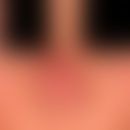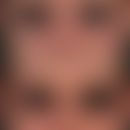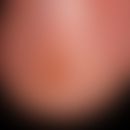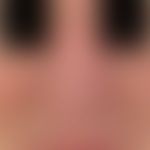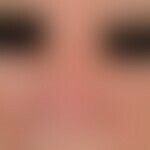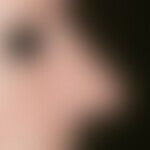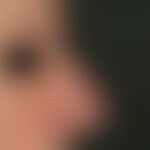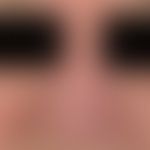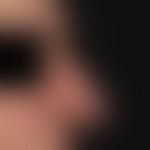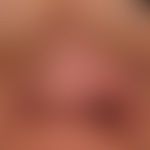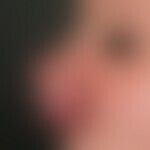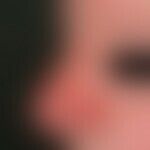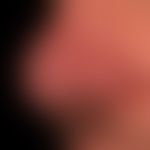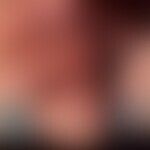Synonym(s)
DefinitionThis section has been translated automatically.
Shaping disorder of the nose due to diffuse or circumscribed connective tissue and sebaceous gland hyperplasia with gradually increasing, localized or diffuse, misshapen, fleshy distension of the nose. Usually a partial symptom of rosacea (stage III of rosacea - glandular-hyperplastic rosacea)
Clinically, a distinction is made for differential diagnostic reasons
- the (more frequent) diffuse rhinophyma and
- the (rarer) localized or circumscribed rhinophyma
Occurrence/EpidemiologyThis section has been translated automatically.
m>w (affected are almost exclusively men/30-50:1); mainly skin type I is affected.
You might also be interested in
EtiopathogenesisThis section has been translated automatically.
Rhinophyma is caused by diffuse connective tissue hyperplasia with hyperplasia of the sebaceous gland follicles and vascular dilatation. The etiology has not yet been clearly clarified. A multifactorial etiology of neurovascular dysregulation, disorders of the innate and acquired immune system, a hyperreactive inflammatory response to cutaneous microorganisms and genetic factors is assumed.
ManifestationThis section has been translated automatically.
5th to 6th decade of life.
LocalizationThis section has been translated automatically.
The lower two-thirds of the nostrils are particularly affected.
ClinicThis section has been translated automatically.
Diffuse rhinophyma: Irregularly configured, painless, skin-coloured or yellow-red, misshapen bulges of the nose with deeply retracted, dilated follicles. This leads to grotesque outgrowths so that the original shape of the nose is no longer recognizable. The proliferated tissue feels soft and elastic. When pressure is applied, a white sebum secretion is released from the follicle openings.
Circumscribed rhinophyma: In this variant, a localised tumour-like nodulation occurs with an otherwise unchanged nose.
The differentiation between "diffuse and localized" is useful, because in the localized form other differential diagnostic considerations come into play.
Tumour-like phymogenesis is also found in other areas rich in sebaceous glands; see also otophym, metophym, gnathophym.
HistologyThis section has been translated automatically.
Differential diagnosisThis section has been translated automatically.
For diffuse rhinopyhm:
- Skin infiltrates in lymphatic leukemia and mycosis fungoides
For circumscribed localized rhinomphym:
- Basal cell carcinoma
- dermal melanocytic naeuvre
- fibrous nasal papilla
TherapyThis section has been translated automatically.
Stage-dependent therapy of diffuse rhinophyma:
- Stage I (edematous changes and sebaceous gland hyperplasia): Tetracycline or isotretinoin.
- Stage II (fibrosis and nodule/nodule formation): Dermabrasion, laser therapy (CO2 laser). Pre- and postoperative tetracycline or isotretinoin.
- Stage III (coarse fibrosis, misshapen nodules, cysts and comedones): Dermabrasion, laser therapy (CO2 laser), cryosurgery, electrocautery depending on severity. Pre- and postoperative tetracycline or isotretinoin.
External therapyThis section has been translated automatically.
Internal therapyThis section has been translated automatically.
In stage 1 systemic therapy with tetracyclines (e.g. tetracycline Wolff Kps.) 3 times/day 500 mg. Alternatively: isotretinoin (e.g. acne normin) 0.1-0.5 mg/kg bw/day for sebaceous gland reduction. The pre- and post-operative administration of isotretinoin to reduce the operating field has also proven to be effective.
Operative therapieThis section has been translated automatically.
From stage 2, surgical removal of the hypertrophied tissue under LA or general anesthesia is recommended. All of the excess tissue is removed, deep parts of the sebaceous glands should be left in place. For secondary wound treatment, see below.
Remember! Therapeutic procedures with a defined depth effect (e.g. dermabrasion) are preferable to less controllable procedures (e.g. electrocautery, cryosurgery) as uncontrolled scarring is less likely to occur!
In stage 2, dermabrasion or laser therapy(vaporization by CO2 laser) is particularly recommended. The advantage of laser procedures lies in the intra- and postoperative reduction of bleeding. In terms of healing time and scarring, the use of lasers probably has no advantages over conventional procedures.
In stage 3, surgical ablation using a scalpel (rhinoshave) or fractional ablative CO2 laser is the treatment of choice. Subsequent fine modulation with dermabrasion or defocused CO2 laser treatment improves the cosmetic results. All excess tissue is removed down to the cartilage, leaving the deep parts of the sebaceous glands intact. From here, secondary wound treatment generally results in good granulation and re-epithelialization. The majority of patients are very satisfied with the results of the treatment carried out properly (Hempel C et al. 2025)
- Note: Transplants and sliding plasty do not show good results. In the case of "blind" procedures, exclude a malignant event beforehand.
Remember! Histologic control of the removed tissue! Malignant or semi-malignant tumors can occur (albeit very rarely) under the image of a rhinophyma!
Progression/forecastThis section has been translated automatically.
Rhinophyma, which has not been treated surgically, continues to develop. After surgical ablation there is rapid epithelialization, usually extensive, cosmetically acceptable scarring.
Note(s)This section has been translated automatically.
The Rhinophyma Severity Index(RHISI) was introduced to determine the degree of rhinophyma. gradations, based on the degree of skin thickening, the presence of fissures and nodular proliferations. The maximum score is 6+1 points (Wetzig t et al. 2013).
LiteratureThis section has been translated automatically.
- Blount BW et al. (2002) Rosacea: a common, yet commonly overlooked, condition. Am Fam Physician 66: 435-440
- Bogetti P et al. (2002) Surgical treatment of rhinophyma: a comparison of techniques. Aesthetic Plast Surg 26: 57-60
- Hae-El G et al. (1993) The treatment of rhinophyma. 'Cold' vs laser techniques. Arch Otolaryngol Head Neck Surg 119: 628-631
- Hempel C et al. (2025) Combination of rhinoshave and fractional ablative CO2 laser therapy for fine contouring of pronounced rhinophyma - A monocentric retrospective study with long-term follow-up. J Dtsch Dermatol Ges 23:815-820.
- Husein-ElAhmed H et al. (2013) Management of severe rhinophyma with sculpting surgical decortication. Aesthetic Plast Surg 37:572-575
- Kopera D (1992) CO2 laser treatment of rhinophyma. Dermatology 43: 298-299
- Metternich FU et al. (2003) Surgical treatment of rhinophyma with the ultrasonic scalpel (Ultracision Harmonic Scalpel). Laryngorhinootology 82: 132-137
- Petres J (1985) Therapy of rhinophyma. Dermatology 36: 433-435
- Rebora A (2002) The management of rosacea. Am J Clin Dermatol 3: 489-496
- Stucker FJ et al (2003) The AbCs of rhinophyma management. Am J Rhinol 17: 45-49
- Tüzün Y etg al (2014) Rosacea and rhinophyma. Clin Dermatol 32:35-46
- Wetzig T et al. (2013) New rhinophyma severity index and mid-term results following shave excision of rhinophyma. Dermatology. 227:31-36.
Incoming links (12)
Alcohol skin changes; Co2 laser; Dermabrasion; Gnathophyma; Metophyme; Nasal papilla fibrosus; Otophyma; Pound nose; Pug nose; Rhinophyma paraphrased; ... Show allOutgoing links (17)
Dermabrasion; Gnathophyma; Hyperplasia; Isotretinoin; Laser; Leukemia cutis; Local anesthesia; Metophyme; Mycosis fungoides; Otophyma; ... Show allDisclaimer
Please ask your physician for a reliable diagnosis. This website is only meant as a reference.


